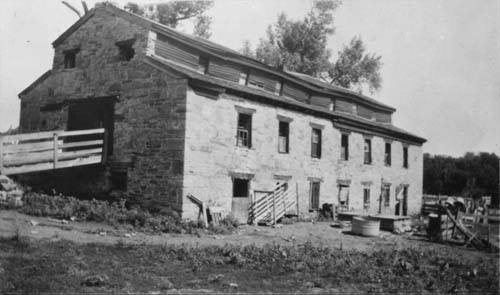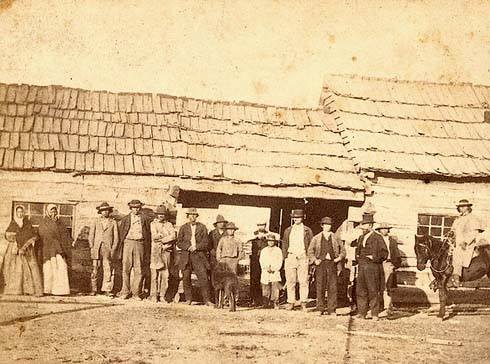Potawatomi Baptist Manual Labor School was built in 1848 and continued in use until 1861. This school has been restored and stands on the grounds of the Kansas State Historical Society just west of Topeka, Kansas. The photo which accompanies this article was taken many years later when it had been converted to a dairy barn.
This school was founded by Baptist missionaries and had one major competitor, the St. Marys Mission of the Jesuits, about 15 miles west of Topeka on the north side of the Kansas River. Both of these missions were developed about the same time, during the mid to late-1840s.
Both of the missions built schools to educate and provide manual training for Native American children. The U. S. Government provided start up funds for both missions and then paid $50-$75 for each student that attended the schools.
Both of the schools were not interested in providing an “education” which preserved Native American Culture—or even attempted to do so. Both were interested in absolutely destroying any evidence of Native American Culture and replacing it with “civilized” European Culture. They wanted to prepare Native Americans to assimilate into the European Culture which had conquered them and taken their lands.
The second photograph is of Native American children who were students at an one of the schools. These were both boarding schools. Native American children were taken away from their parents in most cases, at the age of five or six and sent away to school. They were stripped naked and their Native clothing was taken away from them and burned. Their hair, which by Native American tradition was long and sometimes braided, was shaved off and they were given European haircuts. They were given European clothing and were forbidden to speak their Native languages. If they resisted or were emotional, they were punished, usually by sending them to isolation or by physical punishment of varying kinds. There were few if any exceptions to these practices until the mid-1900s.
Potawatomi brothers, Joseph Napoleon and Jude W. Bourassa, were important Potawatomi spokesmen. They were in effect the leaders of the Potawatomi from the time they were removed from their homelands in 1838 until their deaths. Both had received significant educations at Native American Mission Schools in Michigan, New York and Kentucky. They dressed like Europeans, were able to speak like Europeans, had beautiful handwriting and were trained in reading, writing, arithmetic and law. I believe it is fair to say that both of them believed that Native American assimilation into European Culture was the appropriate decision.
They lived as Europeans. I’ll provide a quote by WIlliam H. Hutter who published a letter about an 1854 visit to the Jude W. Bourassa home located on Mill Creek near its concurrence with the Kansas River:
“On our return trip we tarried several days at the house of Jude Bourassa, a French half breed, about one mile and a half from the Pottawatomie payment post [Union Town]. [13] We found a comfortable double Indian House, of logs of course, one end of which, in all of them, serves the purpose of a better bed room, and also of a parlor to entertain guests. That end was given us with two good beds, a blazing fire in the chimney, and imported carpet on the floor and a handsome modern Piano in the room. We had a capital supper and in the evening prevailed on Mr. Bourassa to bring his daughter Isabella in to play for us. She played Russian march — Washington march and some other beginner’s tunes — the only merit of the music being that it came from an Indian girl. She is a modest, good-looking girl, dressed with neatness and taste — not near so handsome, however, as the Spotted Fawn. Her Father has a brother residing in this immediate vicinity, named Joseph Bourassa. Both were educated, with others, among whom was the well known Jose [i.e., William] Walker of the Wyandots, at Hamilton, in the State of New York. They both speak English, with a French accent, but Joseph is the more intellectual man, whilst Jude is much the more wealthy.”
So this is a little more of the early history of Maple Hill Township and one of its earliest families.

